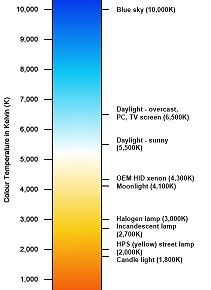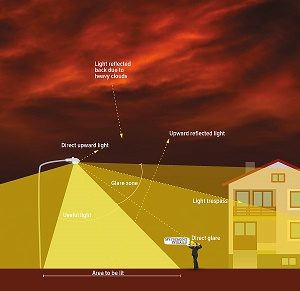
By Anne Hayek
Why is street lighting quality important ?
It makes green energy not just efficient but also healthy AND ecological!
A recent Green Needham article provided information about Needham’s May to July LED street light pilot and encouraged residents to weigh in.
Here’s an opportunity to learn more about what you will be looking at. After all, changing our street lighting is an important decision the Town will make, that will impact public health and safety, wildlife, and our quality of life for decades. Let’s consider two important attributes – color temperature and shielding.
First, let us consider color temperature.
The higher the temperature (degrees K) the bluer the light. Bluer light at night affects humans by suppressing melatonin production in our bodies. Melatonin is an important hormone that regulates our circadian rhythms (sleep cycles), synchronizing the entire body’s daily functions. The American Medical Association is very concerned about excessive blue light at night leading to elevated rates of various diseases including certain types of cancer and recommends an absolute maximum of 3000K for human health. You can read their 2016 report here.
The nocturnal creatures sharing our habitat also need darkness at night to thrive and reproduce. Excessive light at night, especially blue light, disrupts feeding, mating, and migration patterns of animals from insects to birds to mammals, and threatens entire species with extinction. Millions of birds a year die when they become disoriented by city lights and crash into buildings or circle endlessly until dying from exhaustion.
Avoiding the worst of the consequences, the good news is that two of the LED pilots offer the AMA-recommended maximum of 3000K at different luminosities. However, 3000K still has more than twice the blue light content – and more than twice the melatonin suppression – of our current HPS amber-colored street lights. 2700K is already visibly warmer in tone to the eye compared with 3000K. Technology is rapidly evolving, and 1800-2000K LED street lights, similar in temp to our current street lights, are just now coming onto the market.
Please also imagine the light you see in the pilots reflected on winter snow…

Second, let us consider shielding.
Like today’s streetlights, these LED ones would be on level with our street-facing bedroom windows. Well-designed shielding directs the light onto the sidewalk and street where the light is needed, and keeps it from entering our homes. When you visit the pilots, examine how the beams of light are emitted and imagine yourself on the second floor of the house next to it. We thrifty New Englanders often like to sleep with our windows open in the summer instead of putting on the A/C, so this is important to our quality of life. Try also looking at an LED test light from 100 feet away (6 car lengths). Can you still directly see the LED light itself in the streetlight fixture? If so, then the light is not well shielded. The AMA report details why direct views of LED lights are harmful and should be prevented by fully shielding them.
Finally, let us consider the color temperature and shielding combined effect.
Proper shielding, combined with a lower color temperature, work together to keep our skies dark. It is energy-smart to direct light to the ground where we need it, avoiding wasteful dispersion up into our night skies. It would also permit us to move toward being able to see once again with the naked eye the thousands of stars that are there, whereas today we can only see a few handfuls here in Needham. We all need stars in our lives to connect with the infinite. Some of us have the means to go north periodically to visit a dark sky sanctuary, but others cannot. As a matter of equal access, then, we need a dark sky here at home.
The migrating birds we love so dearly also need a dark sky to navigate by the stars.
Local astronomers at nearby Wellesley College could also use some more darkness in the night sky to do their research work. The current benchmark in quality outdoor lighting is Sherbrooke, QC, which chose 2200K fully shielded for their LED upgrade. This city is also located near an astronomical telescope station.
Good lighting design avoids glare: direct, bright light to which your eyes react by closing down your pupils, whereas to see well at night, we need our pupils to open. Combining glare resulting from poor shielding with bluer light is particularly unsafe. The goal of streetlights is to improve visibility; glare makes visibility worse, not better. The good news is that we can both have our cake and eat it too: good lighting design directs light without glare to the ground, where it is needed.
So please do visit the pilots and think about what you are seeing in these contexts. Empowered and educated citizens can extend or widen this pilot with their rich feedback, beyond an up or down vote. Street lights are an investment in our quality of life: it’s important we get it right as a community.
Additional resources:

